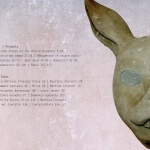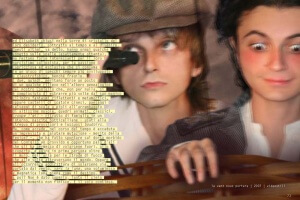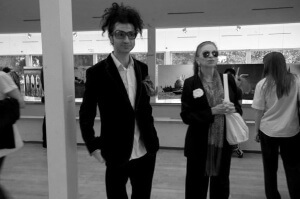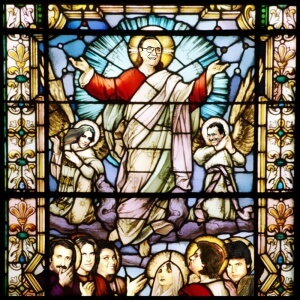Achille Bonito Oliva – The rebus room, the door of the moment
Lacan places art under the parallel sign of critical paranoia. Both work with repetition, multiplication and dissociation. “The iterative identification of the object” becomes the movement of a paradoxical awareness, the opening of an aperture that yields no light. The artist merely lives near the door, in a house that can only tolerate the minimal, naturally well-oiled furnishing of a domestic hinge that appears to promise a great many acknowledgements, revelations and illuminations. Yet no-one comes through it.
So the artist knocks on his or her own door, creating an incumbent expectation that borders on silence. He never abandons his waiting position, not moving a muscle, but prepares himself by assuming a position, that of the long neck, a retractile movement that enables him to rise up out of himself, to detect and at the same time distort things. We know, and it is probable, that the artist is a man with no head on his shoulders, and therefore no neck either, we all realise it: this evident fact is also taught to children in schools, something that is condemned as a sign of irresponsible asociality. The artist, as Thomas Mann says, is not a good reformer, due to his particular love of vulgarity and life, which in the end are the same thing.
The artist does not organise reserves, or accumulate supplies, or wait for someone else to bring him gifts to exchange, because he does not have eyes to hear or ears to see. So he knocks on his own door, thus giving rise to an iterative spectre beyond the door that goes in and out. Like the tortoise, the artist takes on the door, carries the door with him and under this shield travels about with his neck outstretched, ready to withdraw having captured a glimpse.
This glimpse inevitably ends where it started. The artist with the long neck makes a peacock’s tail and finds himself discovering repetition, his own body like a simulacra waiting behind the door. Basically the artist never expects visitors so he consoles himself by opening up and closing himself behind and outside the door, which in this way functions as a mirror. And there, on this concave and specular shell, the past buries its future, and the glimpse turns into an oversight and perverse hallucination of many ubiquities.
Putting his neck round the door means exposing something perturbing, like saying that Lacan opens the door and finds Freud waiting for him! In any case the artist loads his neck on his shoulders and continues his journey, listening out for other apparitions, ready for other revelations, and to fling the door open on the absence of the other.
The creak of the door contends with the muffled sound of laughter, artist’s laughter, that of Zarathustra, who knows how opening the door only means moving air and inevitably placing the door in the domain of time: the door of the moment.
Here space and time no longer coincide, no longer engage like fortunate coincidences. The prudent geometry of the aperture cannot contain the incursion of the spectre that rushes in swiftly and tumultuously, we might say, at breakneck speed. The invasion happens without reason, otherwise it would not be possible to laugh, to spark off the disinhibiting process of laughter that checks comparison and the advent of absence. Also because Lacan warned the artist that reality is impossible. So art becomes the practice of the long neck that expands its own circumnavigation, exploiting the confirmation received, comforted by the information that outside lies the desert, and perhaps not even that…
Thus art becomes the compensation for a wait that leads to no visitor, a way of playing the double role of guest and host, of those who deceive the wait with Nietzschian tactics, speaking out loud and at the same time not speaking, in order to give rise to the illusion of a meeting. Humorously the artist gets to work, following the new adage: seek and you shall not find. In this way he manages to and at the same time practices distancing himself from every meeting, reducing the real to a mere encumbrance, the mechanical movement of opening and closing the door. Opening and closing the door of the moment becomes a paper fan that moves the air, a jagged movement that covers and uncovers alternations of details, flashes of figures and bursts of signs.
Without effort and without work, with much ostentation, that however does not mean without skill, the artist repeatedly goes up on his neck, with the style of his neck, lightly producing the meaning of a Zen proverb: “Clapping with one hand.”
The artist has only one hand, which is focussed and obsessed with expertise, with the sparkling and nocturnal use of the left hand. The artist’s hand is proverbially sinister, strengthened by a peal of laughter that isolates and amplifies the gesture. Satisfied with his own incompleteness, the artist perfects his own mutilation, cutting off his right hand (if it ever grew) in the hinge of the door. Basically the artist puts his right hand in the door, which means out of the picture. Having thus disarmed himself, he prevents the right hand from knowing what the left is doing, thus losing all reserve and brazenly leaving his artfully done works open to view.
Achille Bonito Oliva

 Previous Post
Previous Post Next Post
Next Post


